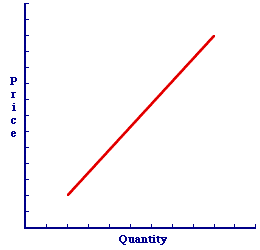
|
|
LABOR-LEISURE TRADEOFF: The perpetual tradeoff faced by human beings between the amount of time spent engaged in wage-paying productive work and satisfaction-generating leisure activities. The key to this tradeoff is a comparison between the wage received from working and the amount of satisfaction generated from leisure. Such a comparison generally means that a higher wage entices people to spend more time working, which entails a positively sloped labor supply curve. However, the backward-bending labor supply curve results when a higher wage actually entices people to work less and to "consume" more leisure time.
Visit the GLOSS*arama
|
|


|

|
                           RESOURCE PRICES, SUPPLY DETERMINANT: The prices of the resource inputs that affect production cost and the ability to sell a particular good, which are assumed constant when a supply curve is constructed. An increase in resources prices causes a decrease in supply and a decrease in resource prices causes an increase in supply. Resources prices are one of five supply determinants that shift the supply curve when they change. The other four are production technology, other prices, sellers' expectations, and number of sellers. The resource prices paid for the use of labor, capital, land, and entrepreneurship affect production cost and the ability to supply a good. If resource prices increase, then production cost is higher and the sellers are inclined to offer less of the good for sale. If resource prices decrease, then production cost is lower and the sellers are inclined to offer more of the good for sale.The Cost of ProductionThe ability to supply a good depends on production cost, or the opportunity cost of employing the four factors of production--labor, capital, land, and entrepreneurship. The corresponding resource prices are wage, interest, rent, and profit.Consider the production and supply of Wacky Willy Stuffed Amigos as an illustration. - Higher Resource Prices: An increase in any of the resource prices causes an increase the production cost. Suppose, for example, that the Stuffers Union, which represents workers who put the stuffing into Stuffed Amigos, negotiates a wage increase. This higher resource price means that The Wacky Willy Company offers less for sale at the existing price. If the price remains constant (by assumption), then the supply decreases.
- Lower Resource Prices: A decrease in any of the resource prices causes a decrease the production cost. Suppose, for example, that the price of thread used to stitch together Stuffed Amigos declines. This lower resource price means that The Wacky Willy Company can offer more for sale at the existing price. If the price remains constant (by assumption), then the supply increases.
Shifting the Supply Curve| Resource Prices |  |
A change in resource prices causes the supply curve to shift. This can be illustrated using the positively-sloped supply curve for Wacky Willy Stuffed Amigos presented in this exhibit. This supply curve captures the specific one-to-one, law of supply relation between supply price and quantity supplied. Resource prices are assumed to remain constant with the construction of this supply curve.Now, consider how changes in resource prices shift the supply curve. - Higher Resource Prices: An increase in resource prices causes a decrease in supply and a leftward shift of the supply curve. With the higher prices, production cost rises and the ability to produce the good is diminished. As such sellers sell less of the good. Click the [Higher Prices] button to demonstrate.
- Lower Resource Prices: A decrease in resource prices causes an increase in supply and a rightward shift of the supply curve. With the lower prices, production cost falls and the ability to produce the good is enhanced. As such sellers sell more of the good. Click the [Lower Prices] button to demonstrate.

Recommended Citation:RESOURCE PRICES, SUPPLY DETERMINANT, AmosWEB Encyclonomic WEB*pedia, http://www.AmosWEB.com, AmosWEB LLC, 2000-2025. [Accessed: July 18, 2025].
Check Out These Related Terms... | | | | | | | |
Or For A Little Background... | | | | | | | | | | | |
And For Further Study... | | | | | | |
Search Again?
Back to the WEB*pedia
|



|

|
WHITE GULLIBON
[What's This?]
Today, you are likely to spend a great deal of time searching the newspaper want ads seeking to buy either an extra large beach blanket or a large flower pot shaped like a Greek urn. Be on the lookout for fairy dust that tastes like salt.
Your Complete Scope
This isn't me! What am I?
|

|
|
The average bank teller loses about $250 every year.
|

|
|
"A winner is someone who recognizes his God-given talents, works his tail off to develop them into skills, and uses those skills to accomplish his goals. " -- Larry Bird, basketball player
|

|
AS-AD
Aggregate Supply-Aggregate Demand Model
|

|
|
Tell us what you think about AmosWEB. Like what you see? Have suggestions for improvements? Let us know. Click the User Feedback link.
User Feedback
|


|


